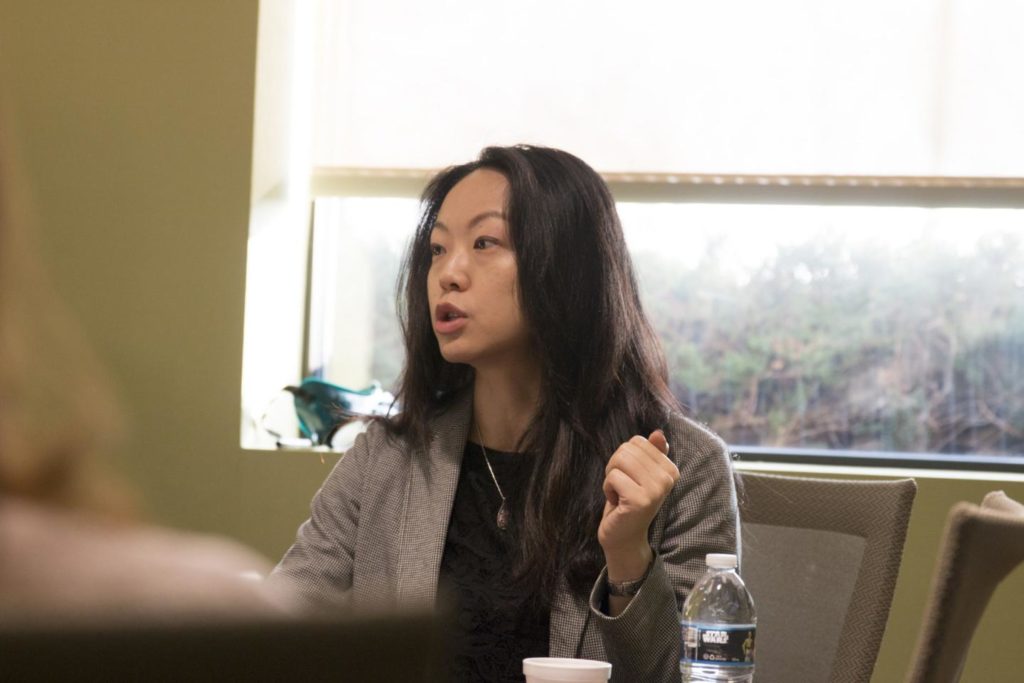East Hanover, NJ. August 30, 2019. A recent report by Kessler researchers and clinicians described the effects of binocular occlusion in a patient with spatial neglect and severe posture impairment. The article, ”
Impact of eliminating visual input on sitting posture and head position in a patient with spatial neglect following cerebral hemorrhage: a case report
,” was epublished on July 18, 2019 by
Physiotherapy Theory and Practice
(DOI: 10.1080/09593985.2019.1645252). The authors are Peii Chen, PhD, of Kessler Foundation, Shannon E. Motisi, DPT, Christina Cording, DPT, Irene Ward, DPT, and Neil N. Jasey, MD, of Kessler Institute for Rehabilitation.
Complications of the hemorrhagic stroke of the right basal ganglia and surrounding area included marked right gaze, severe postural asymmetry, and inadequate responses to multi-step commands. These symptoms limited the ability of the 53-year-old woman to participate in therapy, and hindered the use of conventional paper-based tools for evaluating her for spatial neglect. Under these circumstances, the diagnosis of spatial neglect was based on the
Kessler Foundation Neglect Assessment Process
(KF-NAP®), i.e., observation of her performance of daily life activities.
The team found evidence in the literature that indicated that some individuals performed better on tests of spatial neglect when visual stimuli were eliminated. They hypothesized that eliminating visual input would increase spatial awareness on the contralesional side, which in turn, would reduce the rightward deviations in gaze and posture. Improving posture and gaze could improve the patient’s ability to participate effectively in her rehabilitation.
To eliminate visual stimuli, the patient was blindfolded during therapy sessions, and the stroke team evaluated her behavior with and without binocular occlusion. They measured three outcome measures: head position, weight distribution, and the degree of contact between buttocks and therapy mat (buttock-mat contact). These measurements were recorded at baseline, during binocular occlusion, immediately after removal of blindfold, and three minutes after removal.
All three measures showed immediate improvement during binocular occlusion, with return to baseline at three minutes after the intervention. “We documented that while the patient was blindfolded, she sat up straighter, and her posture was more centered,” said Dr. Chen, senior research scientist in the Center for Stroke Rehabilitation Research. “It is unclear why visual stimuli was such a strong factor in this patient’s symptoms of spatial neglect,” she said.
Further research is needed to investigate the usefulness of this type of intervention in rehabilitative care. “It is important to look at ways to support upright and centered posture in our patients recovering from stroke,” she noted, “because posture and positioning are essential to participating in many therapies and in performing activities of daily life.”
###
About the Center for Stroke Rehabilitation Research
The Center is a leader in rehabilitation research to improve outcomes in stroke survivors. Researchers collaborate with clinicians at Kessler Institute for Rehabilitation to identify obstacles to recovery and develop new ways to treat deficits in cognition and mobility, toward the goal of maximal independence and quality of life after stroke. Researchers apply the latest technologies to interdisciplinary research in spatial neglect, reading deficits, medication compliance, and mobility impairments. Research tools include innovative applications of neuroimaging, brain stimulation, mobile imaging technologies, robotic exoskeletons, and virtual reality. Neuroimaging studies are conducted at the research-dedicated Rocco Ortenzio Neuroimaging Center at Kessler Foundation. Kessler researchers and clinicians have faculty appointments in the department of Physical Medicine and Rehabilitation at Rutgers New Jersey Medical School.
About Kessler Foundation
Kessler Foundation, a major nonprofit organization in the field of disability, is a global leader in rehabilitation research that seeks to improve cognition, mobility and long-term outcomes, including employment, for people with neurological disabilities caused by diseases and injuries of the brain and spinal cord. Kessler Foundation leads the nation in funding innovative programs that expand opportunities for employment for people with disabilities. For more information, visit KesslerFoundation.org.
Stay Connected
Twitter |
http://Twitter.
com/
KesslerFdn
Facebook |
http://Facebook.
com/
KesslerFoundation
YouTube |
http://Youtube.
com/
user/
KesslerFoundation
Instagram |
http://Instagram.
com/
kesslerfdn
iTunes & SoundCloud |
http://Soundcloud.
com/
kesslerfoundation
For more information, or to interview an expert, contact: Carolann Murphy, 973.324.8382,
[email protected]
.
Rob Gerth, 973.323.3675;
[email protected]
This part of information is sourced from https://www.eurekalert.org/pub_releases/2019-08/kf-evs083019.php
Carolann Murphy
973-324-8382
[email protected]
http://www.KesslerFoundation.org


